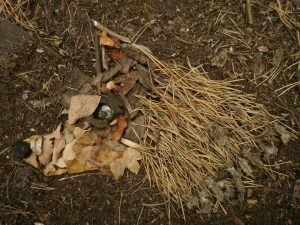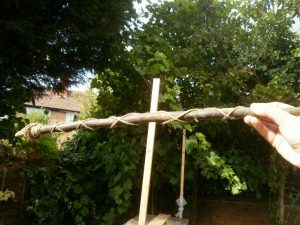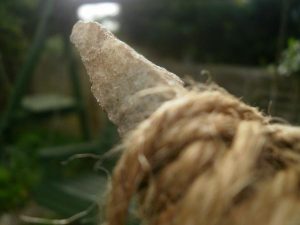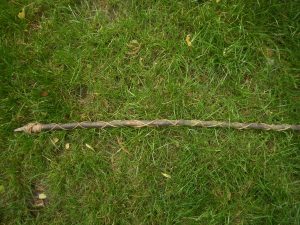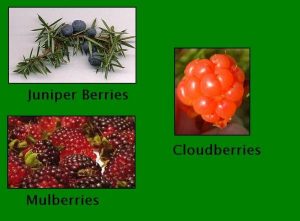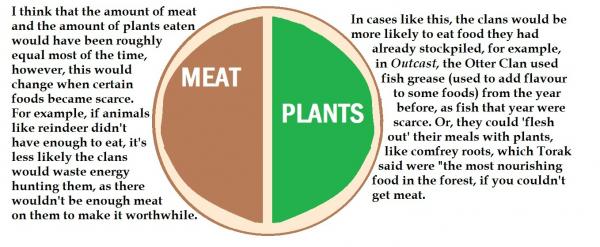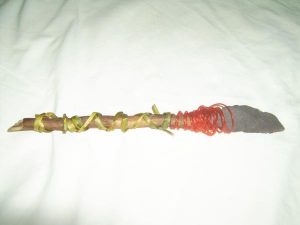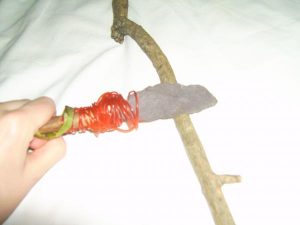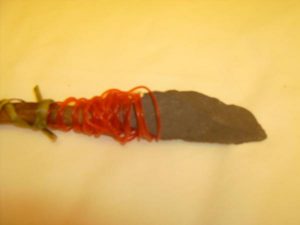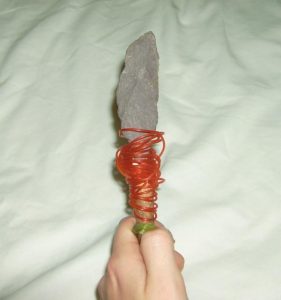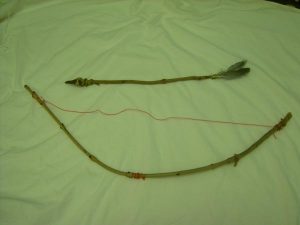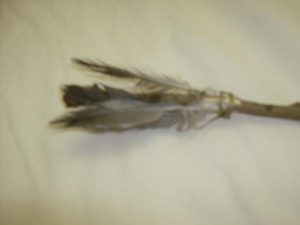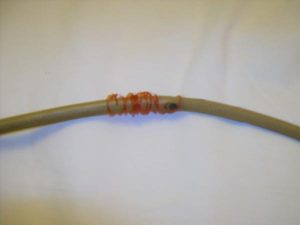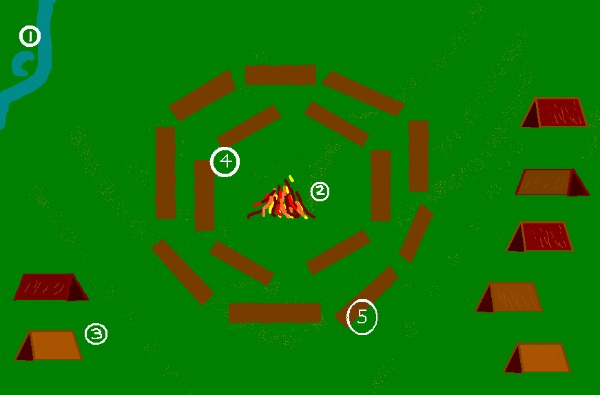Food And How To Get It
An example of how I think the hunter gatherers might’ve made art using limited materials.
A spear used for hunting, made out of a branch and a shard of flint/ some kind of rock, string tied round for grip.
Generally, if a plant tastes bitter, sour, turns your tongue numb or tingly, or has a milky sap inside, it is poisonous to eat.
There were a lot of berries that were safe to eat, but there were also many which were poisonous. A general rough guide to which berries are edible is: No white berries, some red berries, most blue berries, all black berries.
Juniper berries were popular, often used to add flavour to other foods. Juniper plants are evergreen and coniferous, and in some species the berries are reddish brown, but in most species they are blue. When they are unripe, they are green, and shouldn’t be eaten.
Another safe berry to eat was mulberries. Mulberries are small and dark purple when they are fully ripe, and red as they ripen.
Cloudberries were also eaten. Cloudberries are named such because of their shape, and they are also extremely delicate. They grow in wet, marshy areas, but not in the water itself. For example, they are more likely to grow on a small mound in a marshy area, so they are clear of the water. Cloudberries are red as they are ripening, and orangey-red when fully ripe. They have quite a few seeds and are actually related to strawberries and apples.
Picture sources:
http://en.wikipedia.org/wiki/Juniper_berry; http://desertvalleygifts.yolasite.com/wax-melting-tarts.php; http://mylittlenorway.com/2011/07/guide-to-cloudberries/
A popular snare was a deadfall. Deadfall snares could be used to trap animals like foxes, however, foxes aren’t the best animals to eat, as the meat doesn’t have much fat in it. Foxes are scavengers, and if it can be avoided it is best not to eat scavengers, as they are often around dead and rotting carcasses. This means the foxes could be carrying diseases picked up from the dead animals.
Deadfall snares work by placing three sticks in a “4” shape (see diagram.) When the animal disturbs the trap, it knocks the sticks out of place and the weight – a boulder or large log – falls on the animal, usually killing it straight away.
Deadfall traps would work well in an area where there are a lot of signs of animal activity. The person could create the trap in the evening, go away, then come back the next morning and see if their trap has caught anything.
Picture source:
http://www.wildwoodsurvival.com/survival/traps/figure4/figure4.html
A common meat eaten by hunter-gatherers was deer. Small deer could be brought down by a person hunting on their own, but it would be easier for everyone involved if there were two or three people hunting.
The hunters would need to be stealthy, so they wouldn’t frighten the deer away, and have a steady hand and good aim with a bow.
When the deer had been shot, it would probably then have been cut into more managable-sized chunks. First, though, the hunter would need to remove the animal’s internal organs. This would be done by making a vertical cut down the deer’s belly (from between its front legs to between it’s back legs), and then the hunter could simply reach in and pull the organs out.
Cutting the deer into pieces would be done by cutting off the legs and sawing each leg in half at the joint, cutting between the neck and the shoulders, then cutting the carcass down the sides of the backbone. Then, the ribs would be cut into smaller pieces and large pieces of meat would be removed from the hindquarters of the deer, to use as steaks, or to roast, for example.
Another animal that was popular was squirrel. Squirrels were often shot, but there are certain snares which can catch them.
Picture source:
http://www.new-forest-national-park.com/red-deer-fact-file.html
Knives were used a lot for preparing food and killing animals. For example, if Renn shot a deer, she could use her knife to slit its throat, to lessen its suffering by killing it quickly. Knives would also have been used to cut up meat to make it a lot easier to eat.
Knife blades could have been made from stone, slate, or bone, whilst the hilts could have been wood, antler, bone, or kelp. The clans would likely have used a resin-type glue to attach the blade to the hilt, but I had to settle for tying it on, even though this makes it less realistic as the only material I had available to tie it on with was plastic, and therefore modern.
I made the knife in the picture out of wood for the handle, slate, for the blade, plastic twine to tie the blade to the handle, and vine wound around the handle for a good grip. The handle isn’t as thick as I would have liked, but the piece of wood I originally used broke in half as I was attaching the blade!
I could have made my knife better by using a thicker piece of wood for the handle and by finding a better, more secure way of fixing the blade to the handle. I had been planning on sawing away a section of the handle to make a flat section in which to rest the blade, but when the wood broke, I abandoned that idea…
Bows were very popular six thousand years ago, and most forest hunters would have had one. A popular wood used to make them was yew, as it was strong but flexible. The leaves, bark, and seeds of yew are poisonous.
A brittle wood would have been no good, as when the bow was drawn (pulled back), it would have snapped or cracked.
Another wood used to make bows was ash. Ash has a good strength to weight ratio, which would have been good for bows as a hunter would want a strong, but lightweight, bow.
Ash wood also has a high resistance to shock, which is
important for bows, as when the arrow is shot, the release of stored tension in the wood causes a lot of shock and vibration, which could damage the wood.
In the Chronicles of Ancient Darkness, Renn uses hazelnuts to oil her bow, which she takes good care of.
Bows were great tools for hunting. The hunter would have to
have had good aim and patience in order to kill anything, but the people of Torak’s time would have relied heavily on archery as a way of getting food, and so would be quite skilled.
An arrow would have to penetrate fairly deeply into the animal being hunted, for example a deer, as if the arrow doesn’t land deep enough, the animal would run away and would require tracking, rather than it dying straight away.
This is especially important, as the people of Torak and Renn’s time believed in not wasting any part of the animal, including blood, for fear of bad luck.
In the picture, you can see a bow and arrow I made myself. The bow made of wood and the string is a kind of plastic twine. In palaeolithic times, bow strings would however have been made from sinew, not plastic, but I settled for twine as an alternative.
The arrow is made from a stick I found (it’s not completely straight, but it’s the straightest I could find) and the arrowhead is a sharp piece of purple slate I got from my garden. I tied the arrowhead onto the stick with a kind of vine I found in my garden and then used a thinner piece to fix on the feathers.
They’re not owl feathers, unfortunately (which would have been used for silent flight).
Also, I’m sorry the string isn’t completely straight. The twine has a natural kink to it and I’m not strong enough to forcefully make it straight.
This is how I have imagined a clan to arrange their camp, focusing on the seating arrangements. I made this picture on my computer.
Number (1) indicates a small river or stream, with an oxbow lake by its side. An oxbow lake is formed when a large meander (curve) of a river is cut off from the rest by flooding.
The two sides of the meander are then joined together, meaning water runs from the straighter section of one side of the meander to the straighter section on the other side, eroding a different path for the water to take. Oxbow lakes can take many years to form, depending on the location. Rivers in areas with high levels of precipitation (rain and snowfall) will take a shorted period of time to form an oxbow lake, as the river is more likely to overrun its banks quicker than in locations which have less precipitation.
The clans are likely to camp near a water source as water has so many uses, from drinking, to cooking with, to washing. However, in Wolf Brother, Torak tells us that it’s not a good idea to camp directly on the bank of a river in case of flash floods. In Spirit Walker, we see the Raven Clan camped by a river in order to make the most of the salmon it holds. Therefore, water can hold food sources too, making it even more important.
Number (2) shows the main fire of the camp. Some clans, like the Raven Clan, used long fires, made by burning entire logs along their length, to provide extra warmth. These types of fires can last for a long time, meaning the clan is free to carry on with their day-to-day activities without worrying constantly about having to tend the fire.
However, not all clans would use this method. For example, Torak and his Fa made their fires in a star shape. Pine is a good wood to burn, as it burns with a lot of heat and a clean flame. Some clans would have burned smaller fires in front of each shelter for extra warmth, with a fire wall (a small wall of stones or wood) to throw back the heat.
Or, a fire could have been built in a pit, or ringed with stones, to stop the flames spreading to other parts of the camp or surrounding forest, which would be disasterous.
Number (3) shows the shelters in the camp. Shelters were vital for survival and warmth. There were various different ways of making them. A popular way was a lean-to, made by suspending a log between two trees, or between a rock and the ground, and leaning other logs vertically against it. Then, leaves and leafmould were added on top to waterproof the shelter.
Number (4) and (5) indicate likely areas where the clan would have sat during meal times. I think that the more important members of the clan like the Leader, the Mage, and anyone with any particularly special skills (for example, someone in the clan responsible for making everyone’s bows, or someone especially good at knapping flint), would have sat closer to the fire and would have a higher precendence in the clan as a whole. The other members of the clan have sat further away, as indicated by the number (5). Of course, some people could have eaten in their individual shelters, rather than with the rest of the clan.
Families would have likely sat together, especially mothers with small children, in order to keep an eye on them. I think that mated couples would also have sat next to each other.
In Palaeolithic times, the clans used fire to cook food. In Outcast, we learn that you can roast fish and large mammals over fires, specifically alder wood.
Alder trees usually grow near streams or rivers, or anywhere with wet ground. Alder wood burns quickly and has a reputation of an excellent firewood. Alder could also have theoretically been used for making bowls and cooking utensils, like spoons, as it’s lightweight and durable.
One method of cooking, mentioned a couple of times during the Chronicles of Ancient Darkness series, was to wrap the raw meat in wet leaves and bury it in the embers of a fire. The embers will still be hot enough to cook the food, but the leaves protect it from the heat, so it doesn’t get burnt.
A similar way of cooking, used mainly for fish, was to cover the meat in clay and place it in the fire. The clay acts like the wet leaves, helping to stop the meat from being scorched.
To prepare food like stews, the people of Torak and Renn’s time would take their waterskin, fill it with water, and add hot stones from a fire. The hot stones would heat the water and would cook any food placed in the waterskin. Common food used was strips of dried meat, with plants like comfrey roots and certain types of mushrooms added.
The most common cooking utensil used was a knife. Clans which lived on islands, mainly by the sea or along the coast, like the Seal clan or Sea-Eagle clan, could have used curved shells or pieces of driftwood as spoons.
In Ghost Hunter, we are told that “meat is good, but fat’s better when you live on the fells.” The Mountain Hare clan ate mainly reindeer, and sometimes lichen.
Lichen is a plant that can occasionally be poisonous, and when eaten raw can cause painful stomach ache. You can cook lichen by soaking it for as long as possible in several different changes of water.
